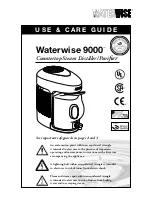
26
RT-SVX069A-EN
setpoint, the thermostat closesW1 contacts the first
stage electric heat contactor (AH or AH and CH) is
energized. If the first stage of electric heat cannot
satisfy the heating requirement, the thermostat closes
W2.
When the W2 contacts close, the second stage electric
heat contactor (BH or BH and DH) is energized, if
applicable. The thermostat cycles both the first and
second stages of heat "On" and "Off" as required to
maintain the zone temperature setpoint.
Heating Operation (for Gas Units) -
Standard Economizer
When the system switch is set to the "Heat" position
and the zone temperature falls below the heating
setpoint, the Ignition module (IGN) initiates a heat
cycle.
Ignition Module Low, Medium and High
Heat
Two-stage (IGN) runs self-check (including verification
that the gas valve is de-energized). (IGN) checks the
high-limit switches (TC01 and TC01) for normally
closed contacts, the pressure switch (PS) for normally
open contacts, and the flame rollout (FR) switch for
continuity. (IGN) energizes inducer blower on high
speed to check pressure switch closure. If the pressure
switch is closed, the inducer blower starts a 20 second
pre-purge (15 seconds on high speed followed by 5
seconds on low speed).
If the pressure switch (PS) is still open, the inducer
blower will continue to be energized on high speed
until pressure switch closure.
After pre-purge completes, the (IGN) energizes the first
stage of the gas valve, initiates spark for 2 seconds
minimum, 7 seconds maximum (ignition trial) and
detects flame and de-energizes spark. From this point,
a fixed 45 second indoor blower delay on timing starts.
After the indoor blower delay on is completed, the
(IGN) energizes the indoor blower. The (IGN) enters a
normal operating loop where all inputs are
continuously monitored. If the first stage of gas heat
cannot satisfy the heating requirement, the thermostat
closes W2. The (IGN) energizes the second stage of the
gas valve and the second stage of inducer blower.
When the zone thermostat is satisfied, the (IGN) de-
energizes the gas valve. The (IGN) senses loss of flame.
The (IGN) initiates a 5 second inducer blower post
purge and 90 second indoor blower delay off at current
speed. The (IGN) de-energizes the inducer blower at
the end of the post purge. The (IGN) de-energizes the
indoor blower at the end of the selected indoor blower
delay off.
Table 8. Ignition module diagnostics
Steady light
Module is powered up, but no active call
for heat.
Blinking at
continuous steady
rate
Active call for heat.
One blink
Loss of communication.
Two blinks
System lockout (failure to ignite, no
spark, low/ no gas pressure, etc.)
Three blinks
Pressure switch (no vent air flow, bad
CBM, closed at initial call for heat). Auto
reset.
Four blinks
High limit (excessive heat in combustion
chamber, low airflow). Auto reset.
Five blinks
Flame sensed and gas valve not
energized or flame sensed and no call
for heat.
Six blinks
Flame rollout (CBM failure, incorrect gas
pressure, and incorrect primary air).
Requires manual reset of the switch.
Seven blinks
W1 and W2 swapped (electromechanical
3-10 tons units).
Two-Speed Indoor Fan Control
For units equipped with two-speed indoor fan control,
standard unit operation for cooling and heating will
continue and all unit functions will operate normally,
except for the control of the indoor fan speed. All units
configured with any type of heating will heat the supply
air and space as normal utilizing full speed indoor fan
by energizing the appropriate outputs. The two-speed
indoor fan unit will only utilize two speeds during the
cooling operation modes described below.
Cooling Operation
For cooling operation, the unit will operate at Low Fan
Speed during Fan Only, Economizer Only, and the first
stage of compressor unit modes by Default. When the
unit receives a call for cooling, if the economizer is
enabled, the unit will energize the associated Low
Speed output and begin to modulate the OA Damper
open above minimum position up to 100% as
necessary. By default, the supply fan will remain at low
speed for the duration of Economizer-Only cooling. If
the supply fan is on when the first stage compressor is
energized, it will remain energized or energize at low
speed for the duration of Cool 1.
When there is a call for Cool 2, the second compressor
is energized and the Supply Fan will switch to High
Speed.
The unit will stage down compressors for cooling in
reverse order that they were staged and the supply fan
will follow the unit mode transitions. Once it is
determined through normal cooling control that the
second compressor is no longer necessary to meet















































